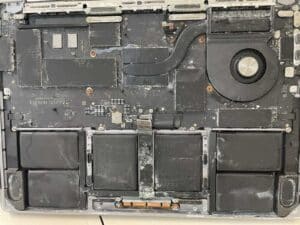How Liquid Damage Affects MacBook Components and How to Treat It
Effects of Liquid Damage on MacBook Components
When liquid enters a MacBook, it can cause severe damage due to electrical shorts, corrosion, and residue buildup. Here’s how it impacts different components:
- Logic Board (Motherboard) Damage
- Liquids cause short circuits by bridging connections that shouldn’t be connected.
- Corrosion develops over time, leading to component failure.
- Chips, resistors, and capacitors can burn out due to liquid exposure.
- Keyboard and Trackpad Issues
- The keyboard has a membrane that traps liquid, causing sticky or unresponsive keys.
- The trackpad can stop responding due to liquid damage affecting its internal circuitry.
- Battery Malfunction
- Liquids can cause battery swelling, overheating, or failure.
- Damaged batteries may no longer hold a charge or function unpredictably.
- Display and Screen Issues
- Liquid exposure can cause screen flickering, black spots, or complete failure.
- Backlight circuits on the logic board can be damaged, leading to a dim screen.
- Storage and Data Loss
- If the SSD or hard drive is affected, data corruption or complete loss may occur.
- Data recovery may be difficult depending on the extent of damage.
- Fan and Cooling System Impact
- Liquid can reach cooling fans, causing them to malfunction or stop working.
- Overheating may occur if cooling is compromised.
- Speaker Damage
- Speakers may crackle, sound distorted, or stop working entirely if liquid reaches them.

How to Treat Liquid Damage in a MacBook
If your MacBook has been exposed to liquid, follow these steps immediately:
Immediate Steps to Minimize Damage
- Turn It Off Immediately
- Hold the power button for 5-10 seconds to force shut down.
- Do not try to turn it back on.
- Unplug and Disconnect Everything
- Remove any connected chargers, peripherals, or external devices.
- Dry the Exterior
- Use a clean, dry microfiber cloth to wipe off visible liquid.
- Place It Upside Down
- Open the MacBook and position it like an upside-down tent to prevent liquid from seeping deeper.
- Remove the Battery (If Possible)
- For older MacBooks with removable batteries, take them out.
- For newer models, this step requires professional help.
- Do Not Use Heat (Like a Hairdryer)
- Excessive heat can damage internal components further.
- Do Not Attempt to Turn It On Too Soon
- If liquid remains inside, turning it on can cause irreversible damage.
Professional Repair and Cleaning Process
If your MacBook has been exposed to liquid, professional repair is recommended. Here’s what the repair process typically includes:
- Disassembly and Inspection
- The MacBook is opened to check for liquid penetration and corrosion.
- Ultrasonic Cleaning of the Logic Board
- A specialized ultrasonic cleaner removes corrosion and residue.
- Component Testing and Repair
- Technicians test key components such as the logic board, battery, and connectors.
- If necessary, damaged parts are replaced.
- Reassembly and Testing
- After cleaning and repairs, the MacBook is reassembled and tested for functionality.
Prevention Tips for the Future
- Use a Keyboard Cover to protect against accidental spills.
- Keep Liquids Away from your MacBook at all times.
- Use a Waterproof Laptop Sleeve when carrying it in a bag.
- Regularly Backup Data in case of unexpected failure.
Need Help?
If your MacBook has suffered liquid damage, bring it to Device Repair Guy at 148 Lambton Quay, 57 Willis St or 104 Manners St, Wellington for a professional assessment. We can diagnose and repair liquid damage effectively.
Let us know how we can help!
